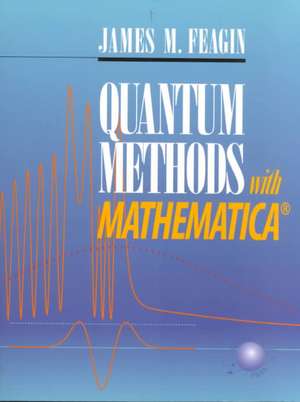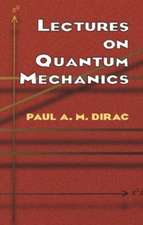Quantum Methods with Mathematica®
Autor James F. Feaginen Limba Engleză Paperback – 7 ian 2002
Preț: 654.77 lei
Preț vechi: 770.31 lei
-15% Nou
Puncte Express: 982
Preț estimativ în valută:
125.29€ • 133.98$ • 104.46£
125.29€ • 133.98$ • 104.46£
Carte tipărită la comandă
Livrare economică 17 aprilie-01 mai
Preluare comenzi: 021 569.72.76
Specificații
ISBN-13: 9780387953656
ISBN-10: 0387953655
Pagini: 482
Ilustrații: XX, 482 p. 18 illus.
Dimensiuni: 178 x 235 x 24 mm
Greutate: 0.82 kg
Ediția:1st ed. 1994. 1st softcover printing 2002
Editura: Springer
Colecția Springer
Locul publicării:New York, NY, United States
ISBN-10: 0387953655
Pagini: 482
Ilustrații: XX, 482 p. 18 illus.
Dimensiuni: 178 x 235 x 24 mm
Greutate: 0.82 kg
Ediția:1st ed. 1994. 1st softcover printing 2002
Editura: Springer
Colecția Springer
Locul publicării:New York, NY, United States
Public țintă
Professional/practitionerDescriere
The first quantum mechanics text published that ties directly into a computer algebra system, this book exploits Mathematica(r) throughout for symbolic, numeric, and graphical computing. It is a work designed for computer interaction in an upper-division undergraduate or first-year graduate quantum mechanics course. It is also a toolbox for the practicing physicist seeking to automate a variety of algebraic and numerical tasks with the computer. The book is divided into two parts: "Systems in One Dimension" and "Quantum Dynamics." Part I emphasizes topics from a first-year course on quantum mechanics, while Part II includes more advanced topics. Although the text requires some familiarity with Mathematica, appendices are provided for gaining experience with the software and are referenced throughout the book. The text is task-oriented and integrated with numerous problems and exercises, with hints for working on the computer.
James M. Feagin is a Professor of Physics at California State University, Fullerton. He was educated at Georgia Tech and the University of North Carolina, Chapel Hill, where he received a Ph.D. in theoretical physics in 1980. He is a Fellow of the Alexander von Humboldt Foundation and has served as visiting Professor at the University of Freiburg, Germany. Feagin is the author of numerous articles on collision physics and the dynamics of few-body systems. He has given a number of invited talks and hosted workshops on incorporating computers into the physics curriculum and is presently helping to introduce computing into the Introductory University Physics Project (IUPP) sponsored by the American Institute of Physics.
James M. Feagin is a Professor of Physics at California State University, Fullerton. He was educated at Georgia Tech and the University of North Carolina, Chapel Hill, where he received a Ph.D. in theoretical physics in 1980. He is a Fellow of the Alexander von Humboldt Foundation and has served as visiting Professor at the University of Freiburg, Germany. Feagin is the author of numerous articles on collision physics and the dynamics of few-body systems. He has given a number of invited talks and hosted workshops on incorporating computers into the physics curriculum and is presently helping to introduce computing into the Introductory University Physics Project (IUPP) sponsored by the American Institute of Physics.
Cuprins
1. Basic Wave Mechanics / 2. Particle in a Box / 3. Uncertainty Principle / 4. Free-Particle Wavepacket / 5. Parity / 6. Harmonic Oscillator / 7. Variational Method and Perturbation Ideas / 8. Squeezed States / 9. Basic Matrix Mechanics / 10. Partial Exact Diagonalization / 11. Momentum Representation / 12. Lattice Representation / 13. Morse Oscillator / 14. Potential Scattering / 15. Quantum Operators / 16. Angular Momentum / 17. Angular Momentum Coupling / 18. Coordinate and Momentum Representations / 19. Angular Momentum in Spherical Coordinates / 20. Hydrogen Atom Schroedinger Equation / 21. Wavefunctions from the Runge-Lenz Algebra
Caracteristici
Includes supplementary material: sn.pub/extras















